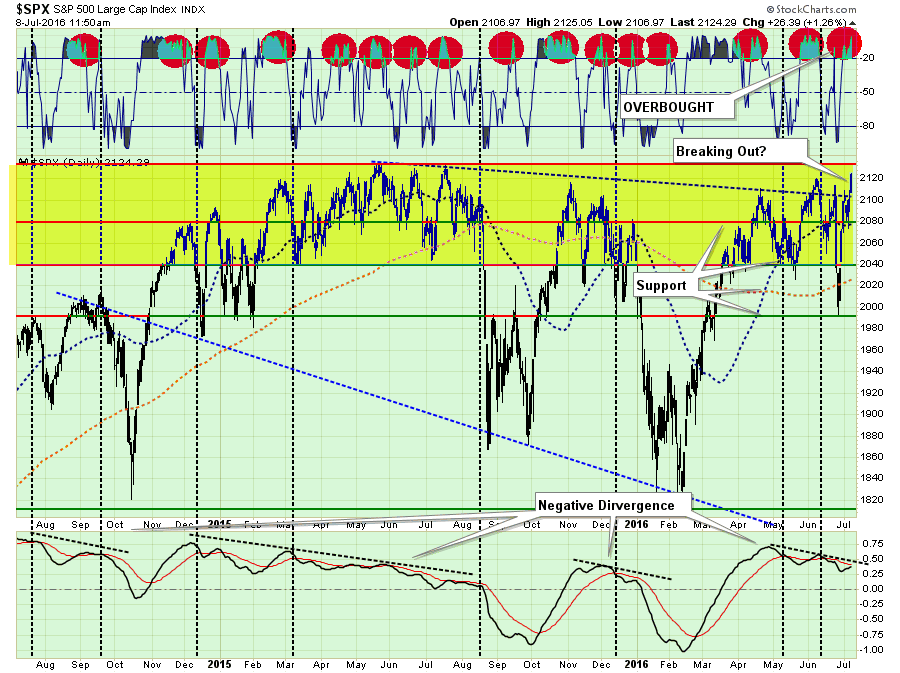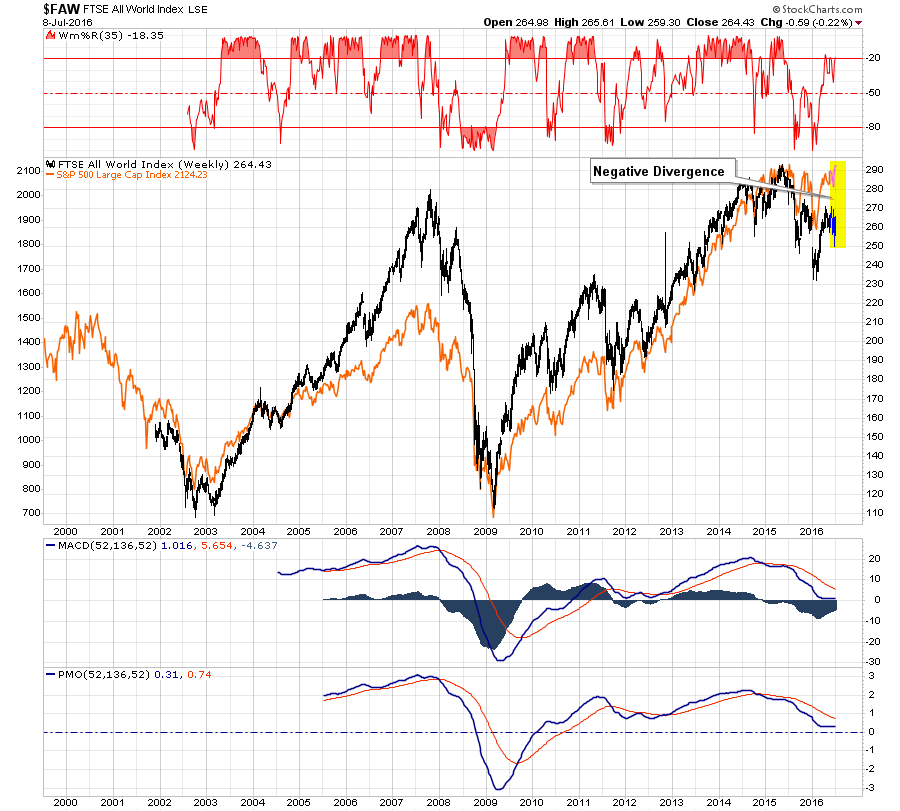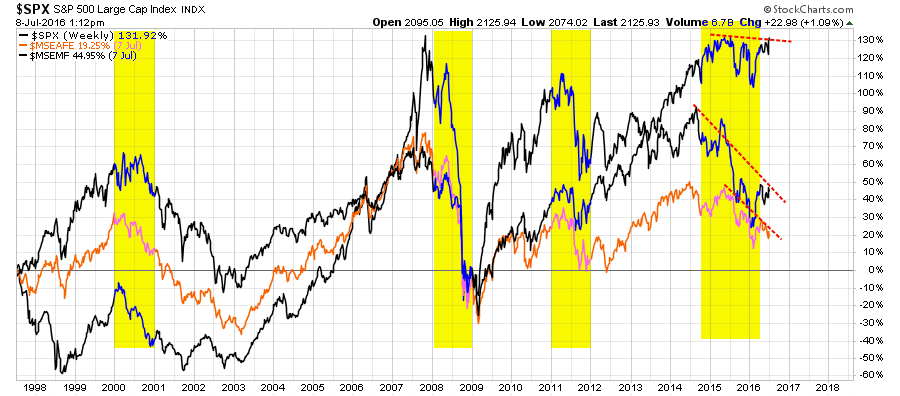Submitted by Lance Roberts via RealInvestmentAdvice.com,
Here we go again. Another Friday. Another attempted breakout above the 2100 level on the S&P 500. Over the last couple of months, as shown below, this has become a regular occurrence.
While the market is once again extremely overbought on a weekly basis, the employment report on Friday which showed a historically abnormal surge in June jobs growth, despite a weaker than expected wage increase and further negative revisions to May’s report, sent investors scrambling into the market. That push on Friday was enough to trigger a short-term buy signal and set the market up for a push to all-time highs.
However, don’t get too excited just yet. There are several things that need to happen before you going jumping head first into the pool.
- We have seen repeated breakout attempts on Friday’s previously which have failed to hold into the next week. Therefore, IF this breakout is going to succeed, allowing us to potentially increase equity allocation risk, it must hold through next Friday.
- The overbought condition on a weekly basis needs to be resolved somewhat to allow enough buying power to push stocks above 2135 with some voracity. A failure at that resistance level could lead to a bigger retracement back into previous trading range of 2040-2100.
- Interest rates, as shown below, need to start “buying the rally” showing a shift from “safety” back into “risk” as seen following the April deviation. (Gold bars show declining rates correlated with falling asset prices. Green bars are rising rates correlated rising assets.)
- Volume needs to start expanding, second chart below, to confirm “conviction“ to a continuation of the “bull market.”
It is important to note, as shown in the chart above, that recent short-term “sell-signals” have been reversed temporarily. However, these are very short-term signals in nature and can be quickly reversed so caution is advised at getting overly excited at the moment.
As shown below, while the market is trying to breakout above 2100, it is doing so with the market, as stated above, extremely overbought and within the context of a negative divergence from longer-term price trends. As shown, these negative divergences have tended to be resolved, although they can take time, with a market correction. Support levels current reside at 2080, 2040, 2030 and 1990.
Importantly, this is not a “bearish” outlook, but rather one that simply suggests caution before adding to current levels of portfolio risk.
As shown in the chart below, the market has continued to vacillate between one event to the next. From central bankers to job reports, the markets have not been trading on fundamentals but rather or not there will be more support from global Central Bankers. The interesting thing about the jobs report on Friday is that it removes another excuse from the Fed NOT to hike rates in July. They won’t, of course, but according to their own data they should.
Just as a side note, the BLS publishes an adjusted employment number which more accurately reflects what is happening in the real economy. To wit from the BLS:
“For research and comparison purposes, BLS creates an ‘adjusted’ household survey employment series that is more similar in concept and definition to payroll survey employment. The adjusted household survey employment series is calculated by subtracting from total employment agriculture and related employment, the unincorporated self-employed, unpaid family and private household workers, and workers absent without pay from their jobs, and then adding nonagricultural wage and salary multiple jobholders. The resulting series is then seasonally adjusted. The adjusted household survey employment tracks much more closely with the payroll survey measure; nonetheless, occasional trend divergences occur.”
This measure of employment actually DECLINED by 119,000 in June.
As noted by David Rosenberg:
“What if I told you that employment actually declined 119,000 in June and has been faltering now for three months in a row? Yes, that is indeed the case.
It’s not as if the Household sector ratified the seemingly encouraging news contained in the payroll data as this survey showed a tepid 67,000 job gain last month and rather ominously, in fact, has completely stagnated since February.
Historians will tell you that at turning points in the economy, it is the Household survey that tends to get the story right.
The simple fact of the matter is that May and June were massive statistical anomalies. The broad trends tell the tale. Go back to June 2014 and the six-month trend in payrolls is running at a 2.2% annual rate and the three-month trend at 2.4%. A year ago, as of June 2015, the six-month pace was 1.9% and the three-month at 2.2%. Fast forward to today, and the six-month annualized rate is 1.4% and the three-month has slowed all the way down to a 1.2%. This is otherwise known as looking at the big picture.
When the Household survey is put on the same comparable footing as the payroll series (the payroll and population-concept adjusted number), employment fell 119,000 in June — again calling into question the veracity of the actual payroll report — and is down 517,000 through this span. The six-month trend has dipped below the zero-line and this has happened but two other times during this seven-year expansion.”
The chart below enhances David’s work by comparing the 6-month annual percentage change of the adjusted employment index as compared to the official payroll measure, the civilian household measure, and the Fed’s Labor Market Conditions Index. Importantly, on a trend basis, all measures have turned lower.
In other words, don’t put on the “party hats” just yet.
FEAR, NO FEAR
Complacency is back. A week ago, the world was awash in digital ink about how the “Brexit” spelled the demise of the world as we know it. As I stated two weeks ago, this was likely NOT to be the case. Now, the markets are acting as if “Brexit” never existed and fears of a market correction have evaporated.
It is worth noting, however, outside of the two exceptions where Central Banks were fully engaged in liquefying markets, when volatility levels have fallen below 15 it has normally coincided with short and intermediate-term market tops.
Does this mean the market will “crash” next week? Of course, not. However, it does suggest that the recent push higher is likely to “run out of gas” in fairly short order.
INTERNATIONAL DIVERGENCE
One other interesting point is the current divergence between international and domestic markets. With money fleeing Europe into the “safety” of U.S. denominated assets, the divergence between asset prices, interest rates (noted above) and international markets is not typical. The negative divergence currently being witnessed will likely not last long and either international markets will begin to garner traction or domestic asset prices will revert.
The same negative divergence is also witnessed between the S&P 500 and MSCI International and Emerging Markets indices.
Again, while this does not mean a market reversion is imminent, anomalies in historical correlations have tended not to be long lasting. It is just something worth considering as an investor.
PORTFOLIO ACTIONS (Reprisal)
As stated above, we need to see the market confirm the breakout on Friday by staying above 2100 for the entirety of next week. For now, it is prudent to use the push higher on Friday to continue to clean up portfolios and prepare for any actions that need to be taken in the near future.
If you have not taken any actions over the last few weeks, this is a good opportunity to clean up and reduce excess risk in portfolios. Continue with the steps laid out in the “Monday Morning Call” Section a few weeks ago:
- Tighten up stop-loss levels to current support levels for each position.
- Hedge portfolios against major market declines.
- Take profits in positions that have been big winners
- Sell laggards and losers
- Raise cash and rebalance portfolios to target weightings.
Importantly, while short-term indicators are turning more bullish, long-term dynamics are still very weak. However, beginning next week we enter into 2nd quarter earnings season and with expectations already VERY low, announcements could provide a short-term lift to the markets.
Major risks to the market still remain the upcoming election and China. Stay tuned.
The post Fear The No Fear appeared first on crude-oil.top.









